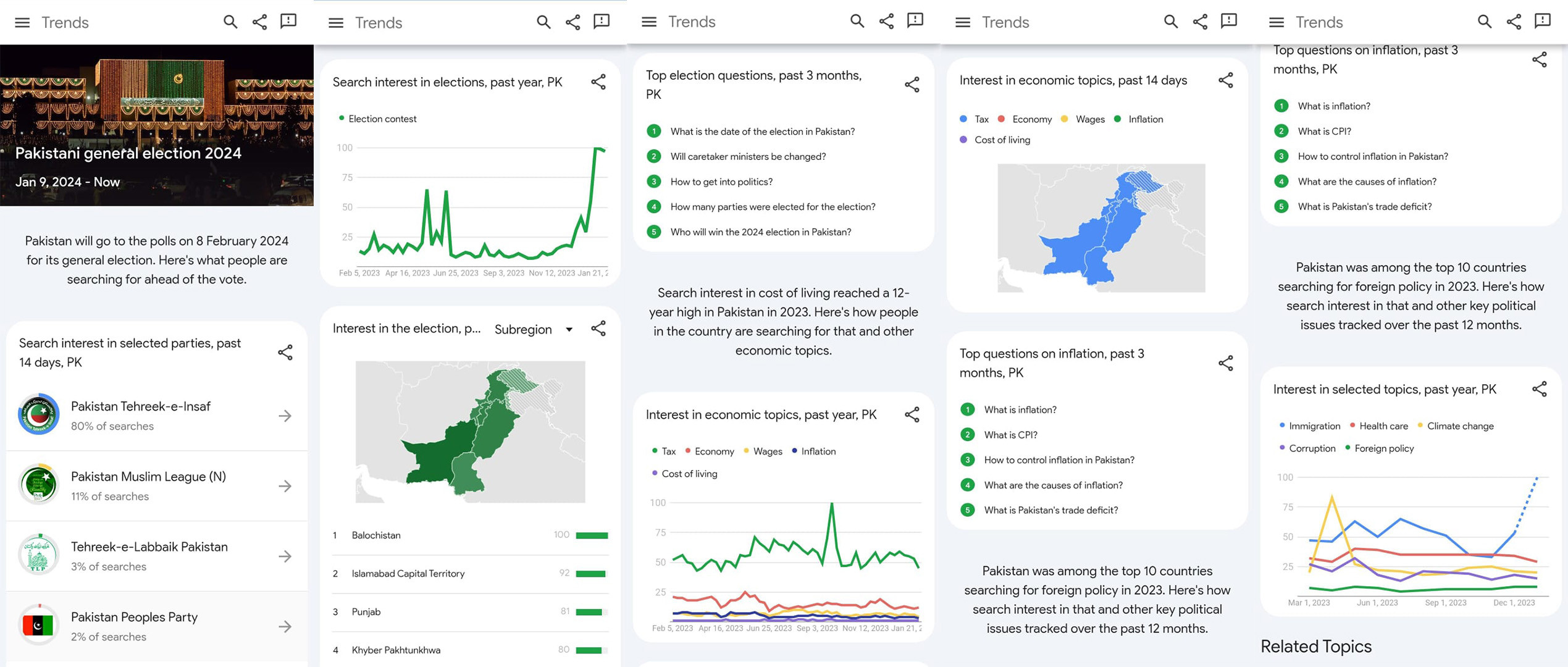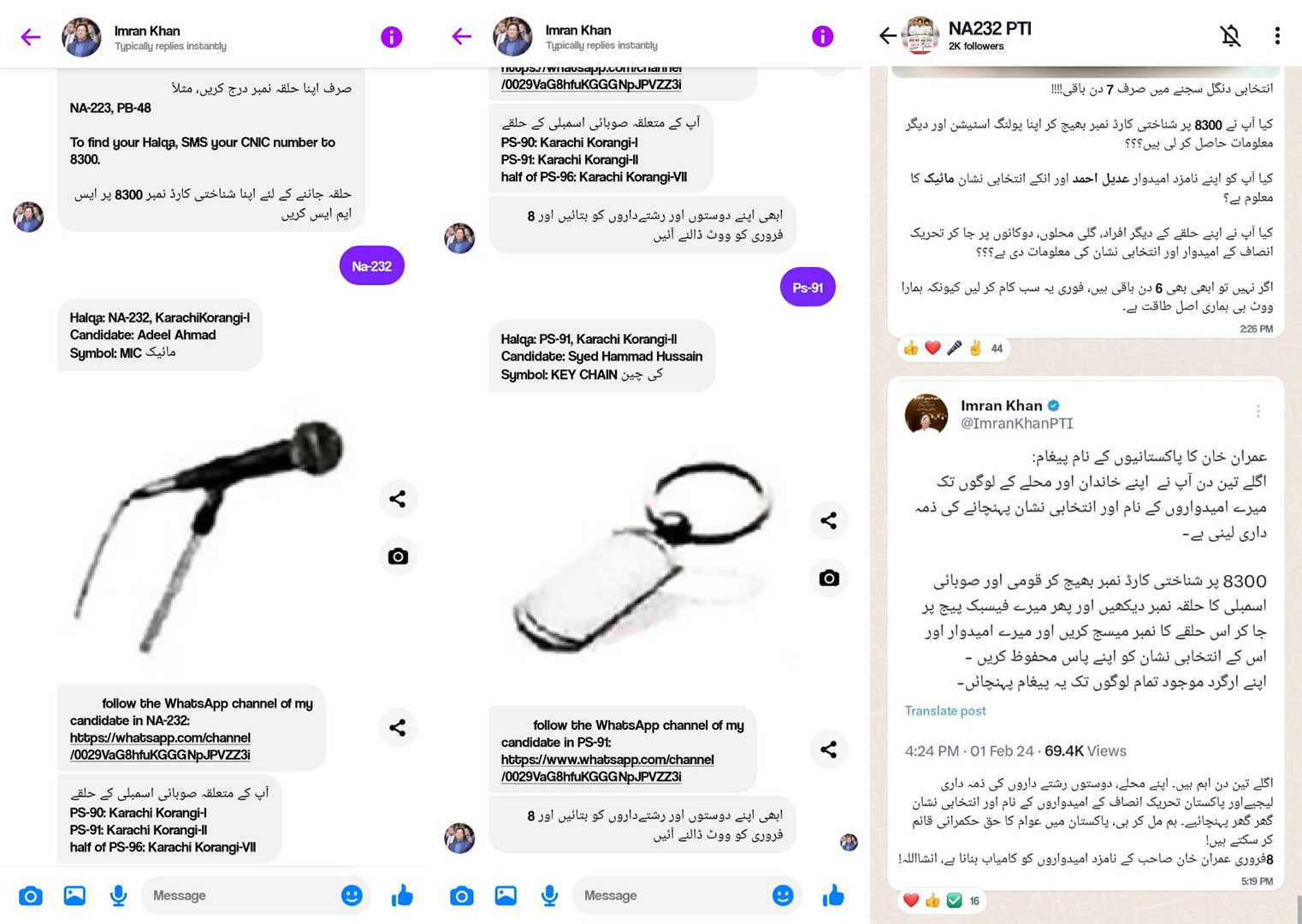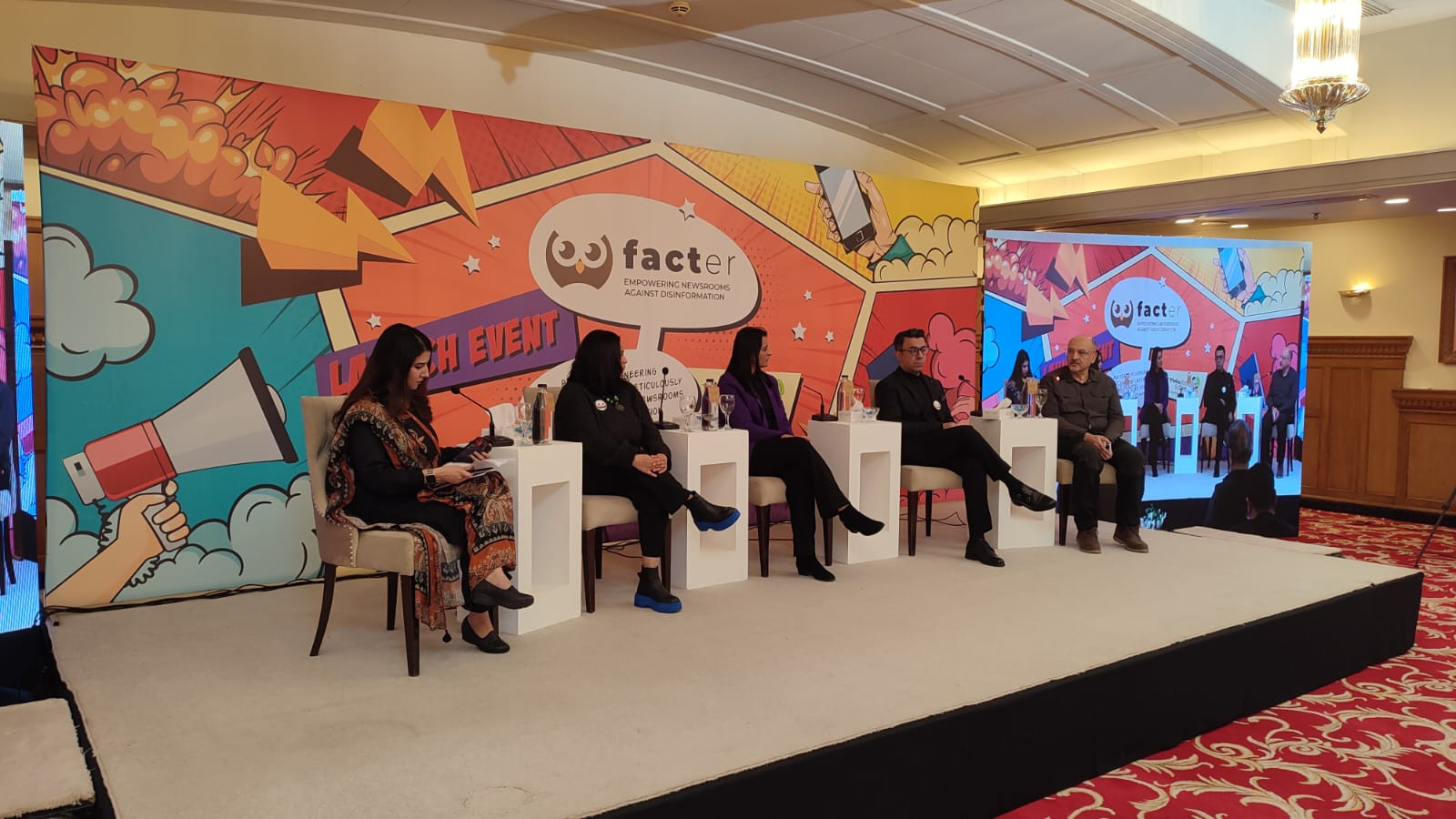Pakistan’s the traditional political battleground has expanded into the digital realm, with social media platforms taking centre stage. In collaboration with the Election Commission of Pakistan, TikTok is set to transform how citizens engage with the democratic process. Simultaneously, Google's search trends keep a finger on the real-time pulse of the public’s mood and concerns about the February 8 elections.
As political fervour intensifies, social media giants Facebook, Instagram, and WhatsApp emerge as dynamic arenas where political parties orchestrate their campaigns. Through these platforms, parties strategically disseminate information, foster public discussions, and craft narratives to resonate with their diverse vote banks.
In an era dominated by virtual connections, political parties are adapting swiftly, leveraging the influential triad of Facebook, Instagram, and WhatsApp to showcase their candidates and disseminate party ideologies. Beyond static posts and curated content, the digital era is witnessing the evolution of political rallies into 'digital jalsas,' where political parties harness the power of live streaming and interactive features to connect with the electorate. These virtual gatherings on social media platforms are redefining the traditional political rallies, and reach a broader audience by being accessible online and fostering a new dimension of civic engagement.
The multifaceted impact of these technological partnerships and social media dynamics on Pakistan's democratic process can be vast. From TikTok's innovative Election Hub to the real-time insights offered by Google's search trends, and the immersive world of digital jalsas hosted on Facebook, Instagram, and WhatsApp — the intersection of technology and politics is creating a revolutionary backdrop for the voters of 2024 in Pakistan.

TikTok's election initiatives
TikTok, a prominent player in the social media landscape, is taking innovative measures to address misinformation and uphold election integrity on its dynamic platform. Recent initiatives underscore TikTok's commitment to foster a secure, authentic, and reliable information environment during the crucial time of elections.
At the forefront of these efforts is the Pakistan Election Centre, a dedicated hub on TikTok available in both English and Urdu. This centre serves as a gateway, directing users to verified information on the upcoming general elections, including essential voting rules and procedural details.
Building on its established framework to counter misinformation globally, TikTok has formed a strategic partnership with well-regarded fact-checking organizations, both regionally and globally. This collaboration is specifically tailored to address the unique challenges of the Pakistani electoral context. Through this active collaboration with local community organisations in Pakistan, TikTok aims to identify and promptly address potential misinformation, ensuring the dissemination of accurate information during significant election-related events.
Central to TikTok's strategy is the implementation of innovative product features designed to enhance user awareness and encourage active participation in maintaining platform integrity. To empower its community further, TikTok has easy-to-use reporting tools. These tools offer users a straightforward mechanism to identify and report potentially misleading content, fostering a vigilant and responsible user base – a crucial aspect during the heightened political climate of an election period.
Beyond information dissemination, TikTok is raising awareness among its users through educational content and in-app guides. These initiatives are designed to equip users with the skills to discern credible information, reinforcing informed participation in the electoral process.
TikTok's efforts against misinformation are reinforced by the implementation of its Community Guidelines, available in both English and Urdu. Using a multi-pronged approach, TikTok ensures the removal of guideline-violating content, redirects search results to authoritative sources, and reduces the chances of spreading unverified information. Through this strategy, TikTok aims to be a safe space free from the harmful effects of election-related misinformation.
Hassan Latif uses TikTok to search for election-related information. "I use TikTok instead of Google for everything,” he said. “Here, I can see real-time, first-hand experiences through short videos.” While searching for election-related information, he discovered the Election Centre. “The best thing is it has all the information one would need ahead of the elections in one place, and all the information is authentic," he explained.
He emphasised the importance of using the app for knowledge sharing and appreciated political parties for leveraging it to raise awareness against misinformation, stating, "It is crucial to get the right information, as people easily believe what they see on social media," Latif said.
As the election approaches, TikTok remains a platform that is a source of creativity while also serving as a responsible guardian of accurate information during the pivotal moments of Pakistan’s democratic journey.

Google's Insights: Decoding Pakistan's Political Curiosity:
Recognising the digital pulse of the nation, Google has launched the Google Trends Pakistan General Election page, designed to offer real-time insights into the political activity sweeping the country.
As citizens gear up to go to the polls and cast votes based on informed decisions, the Google Trends page emerges as a valuable resource. It provides a dynamic showcase of the top search queries, trending topics, and interests related to the contesting political parties. This innovative tool is poised to offer both media outlets and the general public easy access to comprehensive data that can guide them through the intricate web of the electoral process.
Key features of the Google Trends Pakistan General Election page include a visual representation of the top election-related topics searched in each part of the country. Covering a spectrum of issues such as the economy, taxes, and wages, these statistics paint a nuanced picture of the diverse concerns and interests resonating across different regions of Pakistan.
What sets this tool apart is its accessibility and embeddable nature. All charts from the Google Trends page can be seamlessly integrated into any website, ensuring widespread dissemination of valuable insights. These charts are dynamic, designed to be updated in real-time even after being embedded on external sites. This ensures that media outlets and the public alike have access to the latest information as the political landscape evolves.
However, it must be stressed that the Google Trends Pakistan General Election page is not a substitute for traditional polls or surveys. Instead, it serves as a unique lens into the collective search interest of the populace over a specific period. A spike in a particular search query does not indicate the popularity or success of a political party; it merely reflects the evolving interests of the people.
Google's commitment to fostering a more informed electorate through accessible and real-time insights marks a significant stride in the intersection of technology and democracy. As the nation explores this digital treasure trove of political curiosity, the Google Trends Pakistan General Election page can be an invaluable compass guiding Pakistanis through the complex electoral landscape.
"As a young voter, the Google Trends Pakistan General Election page is like a digital compass, helping me navigate through the vast landscape of political information. It's a dynamic tool that reflects the pulse of the nation, empowering us to make informed decisions at the polls,” says Fatima a young female voter.
Digital Jalsas: Political Parties' Online Rallies
The traditional landscape of political rallies is undergoing a revolutionary shift, ushering in the era of digital jalsas. These vibrant online gatherings, broadcasted live across social media platforms, are reshaping how political parties engage with voters in the digital terrain.
The format of a digital jalsa is dynamic, and offers a spectrum of possibilities. From virtual leader speeches to interactive voter sessions, the emphasis is on engagement. Party followers are encouraged to share, comment, and use specific hashtags, which create a virtual wave of support that transcends geographical boundaries.
Several factors have ignited the meteoric rise of digital jalsas in Pakistan. First, with increased internet access, particularly among the youth, digital platforms have become a powerful medium for political engagement. Second, digital jalsas offer a viable alternative to traditional rallies, free from permit issues and resource constraints. Third, facing constraints on traditional media coverage, political parties turn to digital platforms, providing a more accessible and unrestricted channel for communication.
The tradition of digital jalsas began in 2023 when Imran Khan orchestrated a massive online rally, sparking a national debate on the potency of online campaigning. Since then, the government has attempted to control outreach by limiting internet connections during such events, raising questions about freedom of expression and fair campaigning.
Following Khan, the Pakistan Democratic Movement countered with their own online rally, showcasing the potential of digital mobilisation across political divides.
While digital jalsas offer advantages, concerns persist. Online algorithms can create filter bubbles, limiting exposure to diverse viewpoints and facilitating the spread of misinformation. The susceptibility of social media platforms to manipulation raises concerns about external actors influencing elections.
"I find digital jalsas on social media captivating. They break the barriers of traditional rallies, allowing us to engage and express support virtually. It's a refreshing shift in political participation, although we need to stay vigilant against misinformation," said a 25-year-old social media user Halima Mansoor.
"As a voter, digital jalsas offer a convenient way to connect with political parties. The online platform transcends physical limitations, enabling broader participation. However, we should be cautious about the potential impact of social media manipulation on electoral dynamics," she added.
Digital jalsas are not a passing trend; they are here to stay. Political parties must embrace innovation and responsible engagement. Whether these online gatherings pave the way for inclusivity or manipulation remains to be seen. The roar of the online crowd will continue to shape Pakistan's political landscape, demanding vigilance and responsible participation from all stakeholders.

Political campaigns go digital
Social media giants Facebook, Instagram, and WhatsApp have emerged as dynamic platforms, empowering political parties to deliver targeted information about candidates directly to the voters. This digital shift has redefined how citizens engage with political processes, making information accessible at their fingertips.
A notable example of this transformative approach comes from Pakistan Tehreek-e-Insaf (PTI), where the party utilises Facebook not just as a social networking site but as a portal to connect voters with their designated candidates. PTI's innovative Facebook service, operating through Imran Khan's official profile, stands as a testament to the party's commitment to leveraging technology for transparent and accessible elections.
The functionality of PTI's Facebook service is strikingly straightforward and accessible without the need for virtual private networks (VPNs). By simply messaging Imran Khan's official account via the chat feature and providing the constituency number, users receive comprehensive information about their designated candidate. This includes not only the candidate's name and political symbol but also convenient links to their WhatsApp channels.
This digital integration serves multiple purposes. Firstly, it offers voters a convenient and efficient means to identify their candidates, eliminating the need for cumbersome searches or complex procedures. Secondly, by providing direct links to WhatsApp channels, political parties foster direct communication channels between candidates and voters, facilitating two-way dialogue and enhancing the accessibility of election-related information.
The case of PTI exemplifies how political campaigns are strategically harnessing the reach and interactivity of Facebook, Instagram, and WhatsApp to amplify their message and engage with the electorate. These platforms transcend geographical barriers, enabling political parties to disseminate information efficiently to a vast audience.
Ameen Shakeel, a first-time voter, shared his experience using social media for election-related information. "I faced difficulty finding details about the candidate I want to vote for,” he said. “Then, I discovered how one leading political party's social media made it easy. I messaged them on Facebook with my constituency name, and within seconds, I received comprehensive information about the candidate. They also shared a link to a WhatsApp channel that provides regular updates about my constituency. This is the right use of technology," he expressed.
Instagram, with its visually engaging format, is a canvas for political parties to showcase the dynamic aspects of their campaigns. From behind-the-scenes glimpses to candidate profiles and campaign highlights, Instagram's visual storytelling capability provides a multifaceted narrative to voters.
WhatsApp, being a widely used messaging app, has become an instrumental tool for direct communication. Political parties are increasingly leveraging WhatsApp to disseminate real-time updates, share policy details, and even organize virtual events. This direct communication approach helps bridge the gap between candidates and voters, fostering a sense of community and engagement.
Canvassing on the web
The political parties are strategically leveraging websites as crucial channels for disseminating information about their respective candidates. In response to intermittent blockages faced by traditional websites, parties are adopting diverse hosting strategies to ensure uninterrupted voter access to vital candidate details.
Embracing a multi-hosting approach, one party stands out for hosting its official websites on various platforms, demonstrating adaptability to potential disruptions. These websites serve as comprehensive repositories of election-related data, providing voters with localized information by entering their constituency number (e.g., NA1, PK1, PS1).
Despite occasional technical challenges, parties are promptly addressing glitches to maintain the functionality of these platforms. Traditional parties’ websites may face intermittent blocks in Pakistan, but users can navigate restrictions using Virtual Private Networks (VPNs), guaranteeing continued access to essential candidate information.
The strategic use of websites by political parties underscores their commitment to transparent and accessible voter engagement. In an evolving digital landscape, these initiatives play a pivotal role in shaping a resilient and technologically adept political ecosystem, ensuring voters have easy access to critical information about candidates vying for their support.

Media consumption and counter misinformation
Media Matters for Democracy (MMfD), a leading media development organisation in Pakistan focusing on Media and Information Literacy, digital rights, and media sustainability, has launched ‘Facter,’ a collaborative fact-checking tool for newsrooms ahead of the general elections.
Designed to counter misinformation, Facter leverages technology to aggregate verified content from various news sources and its own monitoring and fact-checking team, supporting newsrooms in delivering accurate information.
Asad Baig, the Director and Founder of MMfD, stated, "Facter is designed to empower credible newsrooms against disinformation. In the age of digital misinformation, our primary challenge is sustainability, both for fact-checking operations and newsrooms. Facter is already being adopted by more than 10 mainstream newsrooms, and we aim to leverage these collaborations to combat disinformation effectively."
To foster sustainable collaborations, Facter functions as both a tool and a platform, streamlining fact-checking processes for newsrooms efficiently.
Asad Baig emphasised, "Facter also aligns with MMfD's long-term goal of enabling newsrooms to enhance web traffic and digital revenue through the publication of verified, credible information. We have successfully piloted similar partnerships with news organisations and are looking to expand with Facter."
In contrast to traditional fact-checking services, Facter exclusively provides content to newsrooms. The tool is currently deployed in 10+ national and regional newsrooms across Pakistan.
As Asad Baig explained, "At a technical level, Facter operates by curating information processed by MMfD's monitoring team and credible media outlets. Trends Monitor, MMfD’s technical toolkit and methodology developed for digital investigations, is employed to monitor social media platforms for mis/disinformation. The analysed content is categorised as suspected information, misinformation (fact checked by MMfD), misleading information (fact checked by MMfD), or verified information."
Additionally, Facter connects newsrooms to an extensive stream of information related to their investigations by aggregating relevant content published by various local fact-checking and media organisations.
Navigating information overload
As the general elections in Pakistan draw near, voters find themselves at the crossroads of an information deluge. With political parties utilising diverse digital platforms, including social media, websites, and online rallies, citizens are faced with an overwhelming array of data about candidates, party policies, and electoral promises.
The proliferation of information, while empowering voters, introduces a complex dilemma — how to sift through the digital noise and discern reliable, unbiased information. Social media platforms, such as TikTok, Google, Facebook, Instagram, and WhatsApp, serve as both conduits of valuable insights and potential sources of misinformation.
Navigating this digital landscape requires voters to critically evaluate the credibility of information, considering the source, fact-checking details, and cross-referencing data. The challenge is heightened by the rapid spread of content on platforms like TikTok, where short-form videos don’t provide the depth needed for a comprehensive understanding of complex political issues.
Political parties, cognisant of the impact of their digital strategies, must also grapple with the responsibility of ensuring the accuracy and reliability of the information they disseminate. The rise of digital jalsas, interactive online rallies, adds another layer to the voter's dilemma, as the dynamic and engaging nature of these events may overshadow substantive policy discussions.
In this era of information abundance, voters must exercise discernment, embracing a proactive role in seeking reliable sources and fact-checking information. As technology continues to shape the electoral landscape, the voter's dilemma underscores the importance of media literacy, critical thinking, and an informed electorate for the democratic process to thrive.
